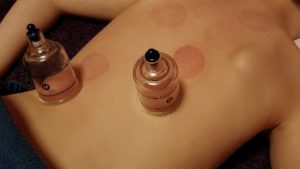 Perhaps while watching the summer Olympics in Rio you noticed – and were fascinated or revolted – by the marks on Michael Phelps’ chest and back that revealed he had been “cupping.”
Perhaps while watching the summer Olympics in Rio you noticed – and were fascinated or revolted – by the marks on Michael Phelps’ chest and back that revealed he had been “cupping.”
Maybe you stopped thinking about it until you saw photos of movie stars, including Gwyneth Paltro and Jennifer Aniston, showing off the same type of marks while they walked the red carpet.
As these stars discover cupping, the media is paying attention, too, but it’s difficult to know how many people are asking for, and receiving the treatment.
What is cupping?
A surprising fact is that cupping has been practiced for thousands of years and is considered a traditional alternative treatment. It seems to have originated in the Middle East but is also widely practiced in Europe and Asia. It is often associated with acupuncture because cups are placed on the body’s meridians, along which the energy of the qi flows.
In treatment, a practitioner places cups made of glass, rubber, plastic or other materials on the area to be treated. The glass cups are heated with a flame before being placed on the skin. As they cool, suction is created, pulling the skin into the cup. Some cups now use small pumps instead of heat to create the suction. Variations include wet cupping, in which a rubber cup is moved from place to place in a treated area. Sometimes cupping is followed by small incisions to allow a minimal amount of blood to flow out.
Why cupping?
Like acupuncture, cupping is used to increase blood flow, loosen tight muscles and open inflamed areas to allow healing blood and other body fluids to treat the irritation.
Studies have been conducted and published on the efficacy of cupping. Many of the studies have been small and not scientifically conclusive, but some doctors point out that the side effects are few and not serious. Therefore, they say, if patients feel better afterward, there is no harm in letting them try it.
Athletes with injuries may find cupping treatment eases pain and speeds recovery, particularly in conjunction with other treatments like massage and acupuncture.
It might also be helpful in addressing acne and in reducing the symptoms of shingles. Claims regarding arthritis, varicose veins or high blood pressure, on the other hand, are unlikely to be proved.
Cupping might cause bruising that lasts for several days but that is the most likely adverse effect.
Should you cup?
Talk to your physician about your symptoms and what other treatments you are receiving. If you visit a cupping practitioner, ask about the person’s training, how long they have practiced, which symptoms they use cupping to treat, and how many sessions they would recommend.
At Mayflower Acupuncture, we educate our patients and share information about the treatments we offer. Contact us at 860-413-2118 or info@mayfloweracupuncture.com to set up an appointment.
Connect with Us!
FacebookLinkedin